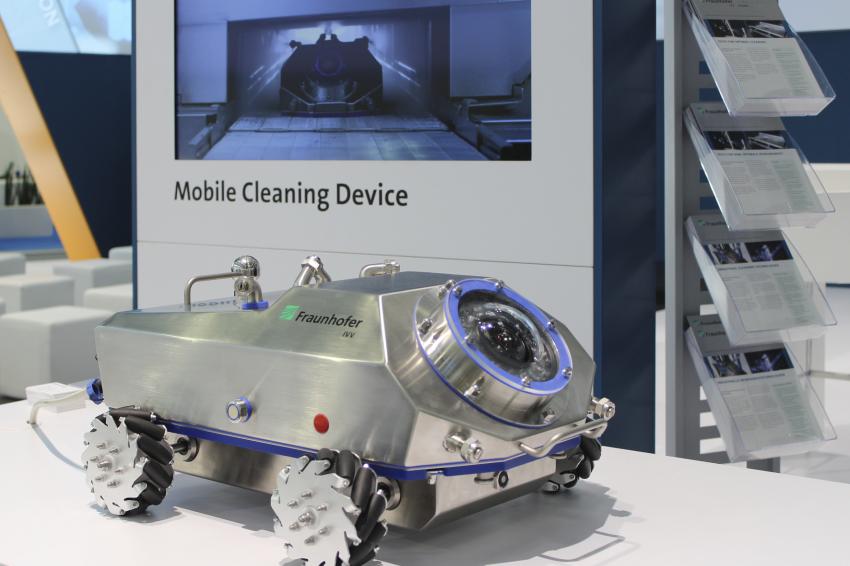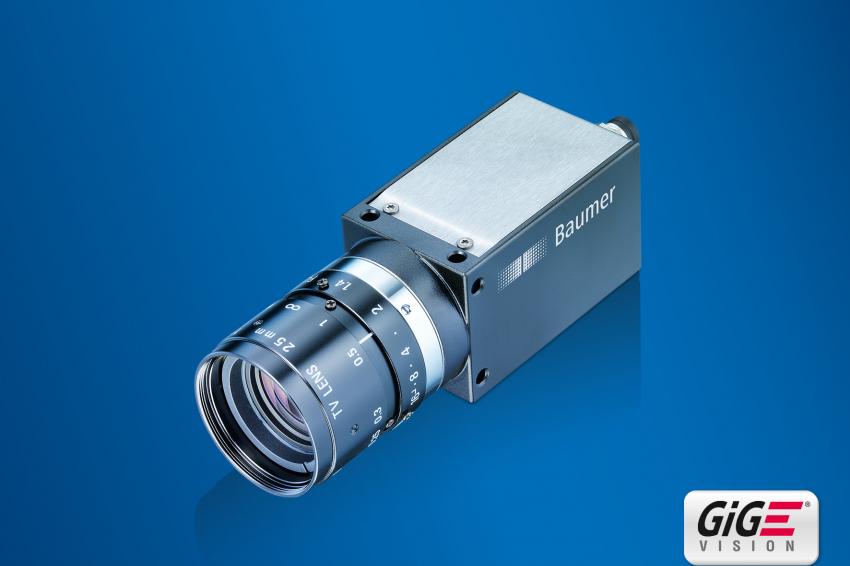Optical Sensor System for Targeted Cleaning in Hygiene-Sensitive Areas
13.03.2018 -
A new Mobile Cleaning Device is able to identify cleaning requirements, determine the relevant parameters for need-based and efficient cleaning and then carries them out autonomously. The Mobile Cleaning Device (MCD) developed by Fraunhofer IVV Dresden has an optical sensor system for soiling detection that enables it to handle the entire cleaning process. For this purpose, the MCD is moved through the installation on the system conveyor belt. In this way the research experts have merged the flexibility of manual cleaning with the benefits of reproducible automated clean-in-place (CIP) processes to save time and resources while increasing process reproducibility.
Developing new cleaning technologies for hygiene-sensitive areas such as food and pharmaceutical production is a central research focus at Fraunhofer IVV Dresden. "Present-day cleaning processes orient towards maximum requirements and hence often waste time and resources," explains Roman Murcek, the MCD project manager at Fraunhofer IVV. Consequently, the industry has a strong interest in automated systems for non-contact, intelligent and targeted cleaning which in parallel allows for better validation of overall efficiency in the cleaning process. Especially with the ever-growing hygiene requirements in food processing, food safety is a prerequisite. Does the cleaning process consider critical spots susceptible to contamination? What’s the type of contamination? What are suitable cleaning media? Was cleaning successful? In manual operations, such questions are answered and evaluated by people with the help of random tests on a local basis, for example by means of dip slide tests.
Cleaning defined by the degree of soiling
The first MCD prototype was developed as part of the EU project "PicknPack" for the development of a flexible and modular packaging system. "Our task was developing a cleaning system where the modular architecture of the installation eliminated the use of conventional CIP systems," Murcek explains. The solution was a flexible mobile device for hygienic cleaning of every surface with product contact without the risk of cross-contamination.
Today the device features seven nozzles which, depending on type and degree of contamination, blast different cleaning media such as water or foam at a pressure of up to 10 bar. The MCD follows the product route on the machine’s existing transport system. A self-propelled system, with the help of either an additional self-propelled module or directly mounted motors and wheels, has been designed for other cleaning tasks without a conveyor belt. While moving, the device emits UV light to detect fluorescent organic dirt particles such as grease residue by help of a camera. "In the most cases, the used UV light creates the best contrast, as the excitation produces hardly any visible light," Murcek describes. According to the detected amount of soiling and spatial dimensions, the MCD will accomplish any required cleaning operation such as foam application in differently soiled spots according to the requirements. Each nozzle can be individually controlled. Cleaning media, water pressure and temperature can thus be varied on one hand and used precisely in order to obtain the optimum result on the other. After pre-rinse, foam application and rinse the result is verified and recorded by the device. The rechargeable battery-powered MCD is WLAN-controlled. "The only physical interface is a hose for media supply," Murcek outlines. The hose connected to the supply station provides the device with water, foam or any other cleaning media – easily and without the need for nozzle exchange.
Flexible, reproducible and cost-saving
The specialized design of the cleaning device provides great flexibility for use in various systems to increase food safety. Compared to manual cleaning operations done by humans, the device is more efficient, reliable and above all ensures reproducibility. "The MCD is capable of reaching spots inaccessible to men without the need for disassembling any machine parts," Murcek says. Additionally the researchers expect significant time savings. First cleaning tests at Fraunhofer IVV have already yielded cleaning media savings of about 20 % compared to conventional CIP cleaning systems. And last but not least, integrated image processing ensures consistent quality assurance and documentation of the cleaning process.
Sensors to fight dirt
The hardware centerpiece of the optical cleaning system is a CX series 5-megapixel GigE camera. "Among other manufacturers, we have often used Baumer cameras in varied test stands, for example in cleaning process monitoring and quantifying or soiling detection on surfaces. Because of the good experience we also relied on Baumer for MCD development," explains Murcek. Good image quality and high camera sensitivity are key in detection of contaminants which are slightly fluorescent under UV light. With a resolution of 5 megapixel, the camera is also ideal for detecting small soiled spots within a large image area without loss of information. Thanks to third-party compatibility, image evaluation is supported by MATLAB and LabVIEW.
Selecting the correct cleaning parameters requires a spatial orientation of the MCD in the machine. For exact position determination, a Baumer IFBR 17 series inductive proximity switch with suitable mounting is used – with completely hygienic stainless steel design. For the last three years, Fraunhofer IVV has benefitted from the manufacturer´s extensive experience in the food and beverage industry with optimally-designed sensors to meet the high demands of food production areas. The IP 69K sensors are jet-proof, corrosion-free and withstand high-pressure cleaning. The hygienically-designed, EHEDG-certified and Ecolab-approved enclosure is chemical-resistant and endures even aggressive cleaning media and disinfectants. The smooth sensor surface with no dead spaces prevents accumulation of dirt and contaminants and ensures hygienic, resilient and reliable MCD position detection.
The virtual twin as future vision
The cleaning device is under continuous development at Fraunhofer IVV as a showcase. "The current version still operates on defined process flow. Present research is about the completely autonomous control by means of a virtual twin of the cleaning installation as well as the software integration of the cleaning sensor system," Murcek explains. Supported by virtual twin simulations, the MCD would be able to determine the cleaning parameters all by itself. These parameters interlinked with the data supplied by the optical sensor system would make it possible to determine exactly where contamination is located. "The system’s CAD data used in combination with specialized software for spray shadow simulation would allow for optimal cleaning processes without the need for extensive practice tests," says Murcek. In this future, the device´s operation is all-autonomous – without prior programming of the process flow. There is strong interest in the industry, and discussions with potential users and sales partners are already underway to make this vision a reality.









